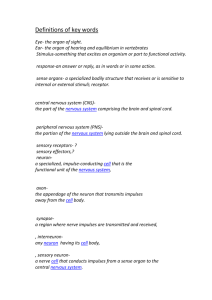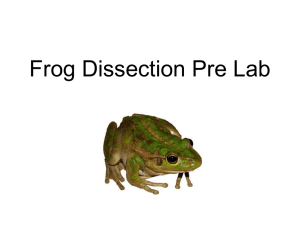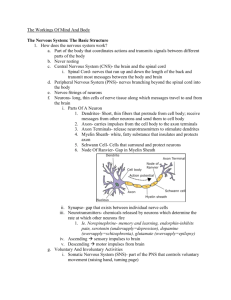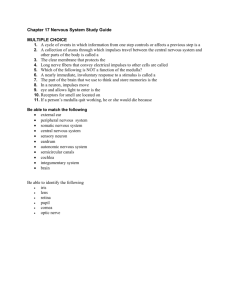Frog - Biology
advertisement
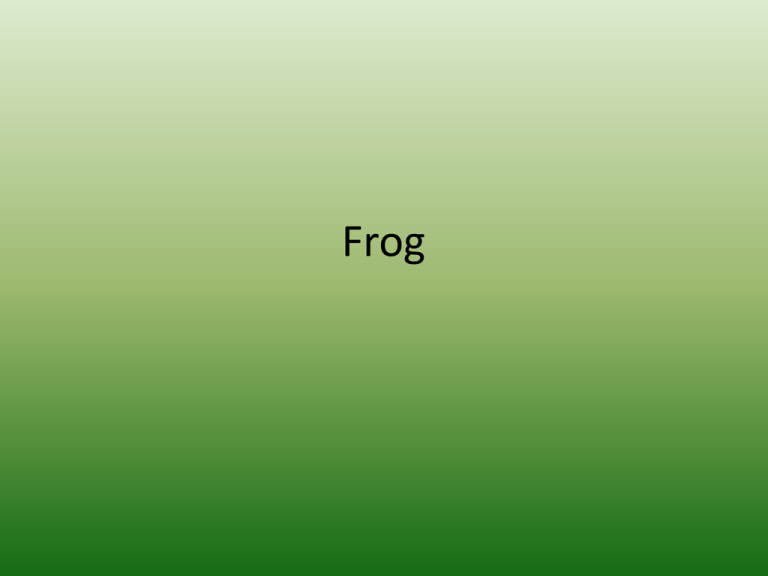
Frog External Structures • Eye – Iris- enlarges or reduces the size of the pupil in response to varying amounts of light – Pupil- opening for light to come in – Nictitating membrane- extra transparent eyelid at the bottom of the eye • Nostrils on top of mouth open into frog’s mouth • Tympanic membrane- serves as an eardrum, transmitting sound vibrations to the ear cavity Digestion 1. Gullet • Tadpoles are herbivores 2. Short esophagus 3. Stomach- enlarged portion of the • Adult frogs are carnivores digestive tract that serves as a storage sac and site of preliminary digestion 4. Pylorus- narrow region of stomach containing a muscular pyloric valve which controls the further passage of food 5. Small intestine consisting of the duodenum and then the ileum absorbs dissolved food into the bloodstream 6. Colon or large intestine 7. Short tubular cloaca- common passageway for solid and liquid waste as well as eggs and sperm during reproduction Mouth • Large sticky tongue attached at the front of the mouth • Internal nostril openings in roof of mouth • Openings to eustachian tubes unite the ear cavity with the mouth, located at the back corners of the mouth • Gullet- passage to the digestive tract, opening to esophagus • Glottis- swelling with slender opening leading to the lungs • Males have openings in the back of the lower jaw that lead to the vocal sacs • Teeth- grasping not chewing – Ridge of tiny maxillary teeth in the upper jaw – Two sets of vomerine teeth between the internal nostril openings Digestion •Liver- 3 lobed gland, produces bile which aids in digestion, also stores some digested food •Gallbladder- stores excess bile •Pancreas- this gland is a small strip of tissue near the stomach, produces digestive enzymes •Bile duct- secretions from the liver, gallbladder, and pancreas are passed to the small intestine through the bile duct •Mesenteries- transparent membranes that enclose all the digestive organs and connect the organs to the dorsal body wall, contain blood vessels Respiration • Frog obtains oxygen by using its skin, mouth lining, and lungs. • Frog does not have muscles needed to inhale and exhale like humans do. Frog essentially swallows the air. 1. 2. 3. 4. Mouth Glottis Trachea Lungs Circulation Excretion • Kidneys • long red brown structures against the dorsal body wall • Filters waste and excess water from the blood and concentrates it into urine • Urinary bladder • Cloaca Reproduction • Female • Ovaries- produce eggs • Oviducts- long coiled tubes lined with cilia • Uterus- stores eggs • Cloaca- ejects eggs during mating • Male • Testes- produce sperm • Vasa efferentia- passageway for sperm from testes through kidneys to cloaca Amplexus- male clasps or wraps around the female which stimulates the female to release her eggs. As they exit the females cloaca they are covered by the male in milt which contains sperm. Nervous System • Central nervous system – Brain- encased in skull – Spinal cord- encased in spinal column • Peripheral nervous system – Nerves that transmit impulses between the central nervous system and the frog’s muscles and sensory organs Divisions of the Five major lobes of the brain, from anterior to posterior: 1. Olfactory lobes ~ receive impulses from the smell receptors of the nostrils 2. Cerebrum ~ controls voluntary muscle activity 3. Optic lobes ~ Receives impulses from the eyes 4. Cerebellum ~ coordinates muscle activity and some involuntary activities 5. Medulla oblongata ~ transports impulses to and from the spinal cord, including some reflexes. Nervous system contains: 1. Brain 2. Spinal cord 3. Cranial nerves (branch from the brain) 4. Spinal nerves (branch from the spinal cord) 5. Sensory organs( eyes, ears, taste buds) Divisions of the Five major lobes of the brain, from anterior to posterior: 1. Olfactory lobes ~ receive impulses from the smell receptors of the nostrils 2. Cerebrum ~ controls voluntary muscle activity 3. Optic lobes ~ Receives impulses from the eyes 4. Cerebellum ~ coordinates muscle activity and some involuntary activities 5. Medulla oblongata ~ transports impulses to and from the spinal cord, including some reflexes. Nervous System


